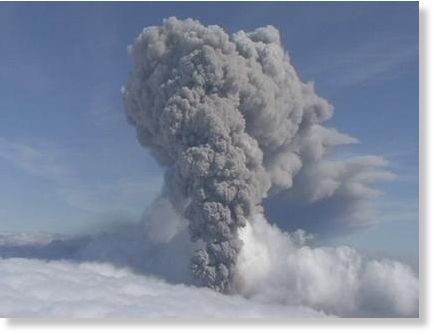Elizabeth Weise
USA TodayTue, 12 Jul 2011 08:51 UTC

© APIn this aerial image from video made Saturday May 8 2010, a renewed column of ash rises from Iceland's Eyjafjallajokul volcano.
Volcanoes may release particles that can cause changes in local and regional weather at rates up to 100 million times higher than previously realized.
The eruption last spring of Iceland's Eyjafjallajökull volcano provided French scientists with the perfect natural laboratory to measure the levels of weather-changing particles released in such eruptions. Taking measurements at the Puy de Dôme research station in central France, they found was that the eruption released much larger amounts of particles at low levels in the atmosphere than previously known.
Volcanoes typically create two types of particles, big primary particles that quickly fall to the troposphere, the lowest portion of Earth's atmosphere, and smaller secondary particles, mostly composed of sulfuric acid, that react chemically with other molecules in the atmosphere and which are responsible for both local and global precipitation changes.
These secondary particles can in turn both help form and seed clouds, changing precipitation levels over large areas.
The underestimation of the "formation rate of new secondary particles in volcanic plumes by seven to eight orders of magnitude" might lead to an underestimation of the ability of formations to contribute to the creation of low-level clouds, they write in their paper in this week's edition of the journal
Proceedings of the National Academy of Sciences.
It is possible that volcanic eruptions and other volcanic activities that release sulfur dioxide into the atmosphere may have a larger effect on climate than previously understood, they write.
Comment: Bingo!
SOTT has been saying that increased vulcanism is behind the increased precipitation for some time now.
Cosmic Climate Change is Underway
Eyjafjallajokull's eruption is another significant marker as we approach catastrophic climate change brought on by the build-up of comet dust in the upper atmosphere. The marked increase in the number of strong earthquakes and volcanism strengthens SOTT's hypothesis that the planet's rotation is slowing down, however slightly, weakening the magnetic field and thus literally "opening up" the planet.
Bear in mind that most volcanoes are underwater, so as they warm the planet's oceans more water is evaporated into the atmosphere where it meets the cooling upper atmosphere and precipitates rapidly as deluges of rain - or, as we've seen above, as snowfall where there shouldn't really be any. We are approaching a tipping point where the feedback loop rapidly locks the planet's climate cycles into ever-increasing precipitation falling back as snow. When we also factor in the low solar activity (sunspot numbers are at a 90-year low) and the planet's intensified water cycle (caused by the warming oceans), an abrupt system shift into a new Ice Age is in the cards. I don't dare call when this will happen, but I'm not alone in thinking that it will happen soon - very soon.




SOTT has always maintained that the increase in precipitation would be the result of underwater volcanism heating the oceans, thereby increasing surface evaporation (of course this assumes that the heat from the deep underwater volcanoes actually reaches the surface, and I've yet to see any hard data supporting this). On the other hand, the above article is proposing an increase in precipitation due to an *entirely different* mechanism, i.e. an increase in condensation nuclei required for cloud formation. It would be nice if SOTT could be a bit more honest about the difference between their proposal and that described in the above article. This is NOT what SOTT has been saying/predicting, so please don't pretend otherwise.